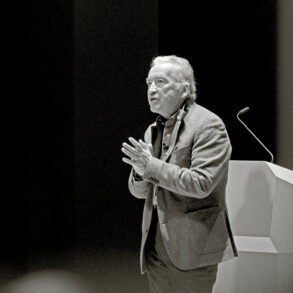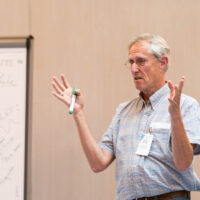The Weil’s hilft [Because it helps] citizens’ initiative collected 200,000 signatures and arranged for a hearing on homeopathy in the German Bundestag. The health minister had to retract his proposal to remove the gentle therapy from medical reimbursement. According to Anna-Katharina Dehmelt, the debate was a shining moment that motivated her to compile ten articles from Info3 on homeopathy and anthroposophic medicine into the book Gute Gründe für Homöopathie [Good reasons for homeopathy.]1 A review by Wolfgang Held.
Georg Soldner makes the first impression in the book, using two case descriptions that uphold the name of the Weil’s hilft citizens’ initiative [”because it helps”]. Two-year-old Maria has a middle ear infection, and three-year-old Joseph has pneumonia. In both cases, Soldner dispenses with antibiotics and activates self-healing using compresses and globules [tiny homeopathic pills]. He is able to treat 95 percent of all children with painful middle ear infections without antibiotics. There’s an interesting piece of information offered by Soldner: Samuel Hahnemann not only introduced homeopathy into medicine but also the use of individual medical histories. Soldner has another “miracle” example to offer: an infant with a heart defect does not gain weight after surgery—arsenic in C30 high potency is given, and the little one gains weight. (C30 means diluting the substance thirty times at a ratio of 1:100 so that no molecule of the original toxic arsenic is left in the remedy.)
What Works Is Legal
In his article, Frank Meyer points out that in anthroposophic medicine, low potencies (D1 to D6) are given for the rhythmic system, medium potencies (D10 to D12), and high potencies for the nerve-sense system. Dilution raises natural substances to a level suitable for human organisms. Interestingly, different potencies could produce polar effects! He speaks about the anthroposophical doctor Heinz Hartmut Vogel, who built a bridge from anthroposophical to homeopathic medicine with his own remedy compositions, which form the basis of the Wala preparations.
Jens Heisterkamp writes about visiting the Dean of the University of Marburg and the Head of Commission D of the German Bundestag, Michael Keusgen. It is astonishing what Keusgen says about homeopathy: “Approved homeopathic and anthroposophic medicines have exactly the same status as all other approved medicines. These are real medicines that have a sufficiently high level of evidence—I must have at least one clinical study for approval, for example, for the treatment of a serious illness. So nobody can claim that homeopathy is somehow voodoo.” The claim that homeopathy is not evidence-based is nonsense, emphasizes Keusgen, adding that other cultures are proud to have their own traditional medicine. As an expert, he could not understand why the professional media would join in the propaganda against homeopathy. Heisterkamp asked Keusgen about the usual criticism that there is no scientifically plausible mode of action and, therefore, no therapeutic effectiveness. “In short, that means that what cannot be, must not be.” Keusgen replies, adding that it is not the pharmacological effect or a cellular molecular mechanism that is decisive but the therapeutic efficacy.
Harald Walach, a qualified psychologist, emphasizes that in Germany, only one study is required to prove efficacy and cites the example of the flu drug Tamiflu, which was purchased at an enormous cost and subsequently disposed of. It later came to light in court that the pharmaceutical companies had withheld negative study results. If one now asks about the proof of the efficacy of homeopathic remedies, it is true that the Drug Commission D of the Federal Institute for Drugs does not have a disease indication but a drug picture. This is why the studies on efficacy were less about approval and more about general interest. Katharina Gaertner from the University of Bern has collected a number of doctoral theses, conference reports, and master’s theses on homeopathy: a total of 636 studies! Walach mentions last year’s meta-study by Harald Hamre: five meta-analyses with sufficient data prove the effectiveness of homeopathy. Walach also emphasizes that currently, researchers with studies that have negative results find it much easier to get included in peer-reviewed literature. Encouragingly, Walach, together with Katharina Gaertner and Stefan Baumgartner, wants to publish a meta-analysis of all studies and summarize further studies that show homeopathy to be effective for other diagnoses. Until then, Walach concludes, one can stick to the existing studies, which already show that homeopathy can do far more than a placebo.
Not a Science of Nature but a Science of Action
Renée Herrnkind reports on the Dutch veterinarian Liesbeth Ellinger. She works successfully with homeopathy to treat contractions, weaning, and diarrhea in newborn piglets and can provide evidence from studies. In an interview with Roland Richter, Berlin doctor Harald Matthes emphasizes that medicine is not a natural science but a science of action. Using the example of psychotherapy for cancer, Harald Matthes shows that healing can also occur beyond particle causality. A study with US students shows something similar. Part of one group was asked to meditate daily. The result: stress genes decreased significantly. How, Matthes asks, can meditation have an effect on something as material as genes? And, he says, 70 percent of the population would like integrative medicine.
In the last part of the book, Anna Katharina Dehmelt reports on the research of Stephan Baumgartner. The physicist has discovered that homeopathic remedies are particularly effective where a process is out of balance and where they promote self-healing. Following Rudolf Steiner, Baumgartner speaks of the “denaturing” of matter, which was condensed from the spirit. This process is reversed during potentization.
This small publication is dedicated to the militant groups working against homeopathy—the skeptics. Just as homeopathic remedies work with the healing power of the organism, the editor Anna-Katharina Dehmelt and her authors rely on the unbiased mind of the reader. This is demonstrated by simple, clear language, closeness to the patient, and an invitation to critics to enter into a conversation about this mysterious medicine because there are good reasons to do so.
Translation Laura Liska









